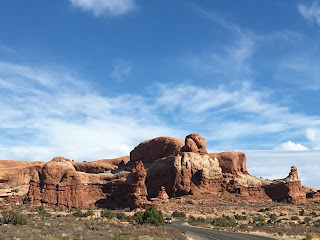I had never even thought of putting the state of Utah on my bucket list until certain "signs" kept pointing me in that direction. Wow, am I now pleased that I listened to those "signs." This is an account of my 10-day trip to Southern Utah in October, 2016--how exciting that I get to relive it as I write about it!
Flew into Salt Lake City (SLC) in Northern Utah on a Monday afternoon, October 10, drove the 4 or 5 hours to Moab in Southern Utah the next morning.
I had been to SLC before when I flew out of it after my Yellowstone and Grand Tetons trip in the spring of 2015.
http://lauramallernee.blogspot.com/2015/06/a-dream-journey.html SLC is a lovely city surrounded by the Rocky Mountains, and that 75-mile-long Great Salt Lake, its 17 named islands, and its Salt Flats are definitely one of Utah's natural wonders. But I was heading out to visit some of her other natural wonders--5 national parks in Southern Utah!
On the drive to Moab, besides the landscape, which was tinged with the yellows of autumn and the bluest skies, the most interesting thing that I observed was a rancher on his horse with his Australian sherpherd in front of the horse and numerous sheep grazing on the mountainous slope behind them.



 |
A rest stop along the way from SLC to Moab. I couldn't stop to get a picture of the sheep farmer/rancher; that picture is only in my mind's eye.
Moah is a quaint little town on the south side of Arches National Park. On Wednesday morning I made my first foray into ArchesNational Park. As soon as you pull into the park, in addition to the sculptured rock scenery--those red rocked pinnacles, balanced rocks, and towering spires--there are the dramatic La Sal Mountains in the near distance!
The park itself is filled with over 2,000 arches, ranging in size from a three-foot opening to a 306 foot opening at the base of Landscape Arch, and in contrast to all the red rock, there are the blue skies and some autumnal yellow flowers, and oh my, those luscious cottonwoods!
I headed toward the arches named North Window and South Window and viewed them from a distance. Then took a short hike to Double Arches.
You do see the people standing there, right?!
Once you are out of your car, the park itself has an intense aura of time, silence and vast scale. Those astonishing balanced rocks are perched atop seemingly inadequate bases. Most of the animals--mule deer, kit foxes, jack-rabbits, cottontails, kangaroo rats and other rodens, and small reptile--are noctunal.
Amid the salmon-colored Entrada Sandstone rock and buff-colored Navajo Sandstone, there are explosions of color. Pinyon and juniper trees add a splash of green contrast to the red sandsone terrain. Wild flowers bloom profusely from April to July. And in this fall season, autumn flowers bloom and cottonwood trees turn the loveliest of soft yellows.
One of my favorite sculptures was entitled "the three gossips." One of my friends quickly renamed it "the three wise women"; I like that better!


On my second day in Moab, I took a break from driving and hiking and rafted the Colorado River, which runs south of the park on its border. There were still many red-rocked formations to view from the river, and it was one of those perfect fall days for a gentle class 3 river trip.
My third day in Moab took me back into the Arches NP that morning to see the famous Delicate Arch. Native Americans used this area for thousands of years. The Archaic peoples, and later ancestral Puebloan, Fremont, and Utes, searched the arid desert for food animals, wild food plants, and stone for tools and weapons.
If you look closely, you can see tiny specks of people hiking their way nearer to Delicate Arch. I stopped at the the trail head near Wolfe ranch, where people were beginning the three-mile hike to Delicate Arch. Most of them had come prepared for such a hike over rough terrain, with plenty of sun lotion, hats, lots of water, walking sticks, and trekking poles. I chose a shorter hike at another trail head--though I could not get as close as they, it was good enough for me!
By the way, Wolfe "ranch" was settled by two of the earlier non-native explorers. John Wesley Wolfe and his son Fred settled there in the late 1800s and operated a primitive ranch for over 20 years. Ranchers in the area found abundant grasses for cattle and sheep. All that remains of the Wolfe ranch is a weathered log cabin, root cellar, and corral.
After I hiked to Delicate Arch, I decided to skip Canyonlands NP, which was an hour's drive in the opposite direction from where I needed to go, and drive to Capitol Reef National Park. I'm glad I skipped CNP because I was fatigued, Even with an interstate speed limit of 80, Capitol Reef was a little further than I expected--a good 3 hours. The scenery from the interstate was not impressive, and it wasn't until I got off the interstate and onto the windy roads that I found Utah's beauty again--especially in Capitol Reef National Park.
to be continued
|


























No comments:
Post a Comment